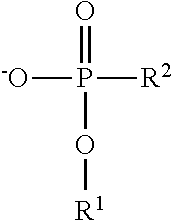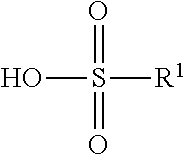Dispersible antimicrobial complex and coatings therefrom
a technology of antimicrobial complexes and dispersants, which is applied in the field of antimicrobial compounds, can solve the problems of non-polar particle association or agglomeration, limited utility of non-homogeneous suspensions, and the most commonly available antimicrobials (quaternary ammonium, phosphonium, etc.) are often not compatible with these surfactants and dispersants, so as to prevent precipitation and/or destabilization
- Summary
- Abstract
- Description
- Claims
- Application Information
AI Technical Summary
Benefits of technology
Problems solved by technology
Method used
Image
Examples
Embodiment Construction
[0020]The invention in one instance provides dispersible antimicrobial complexes that can be dispersed and preferably suspended in either (a) an organic carrier such as oil or a dispersion in oil or (b) an aqueous carrier such as water, a water-based solution, or an aqueous dispersion. A dispersion may have liquid or solid particles and can be in such forms as a suspension and / or a colloid such as a latex or an emulsion. The particles of dispersible antimicrobial complexes can be e.g. part of a solution or dispersion that can be applied to a surface to form a coating.
[0021]Dispersible antimicrobial complexes may have two portions, a cationic antimicrobial portion and an anionic surfactant-compatibilizing portion. These two portions complex together, with the ionic attraction of the two portions typically being greater than the attraction to other ions present in the solution (and preferably their ionic attraction being greater than the attraction to any other ions present in the sol...
PUM
| Property | Measurement | Unit |
|---|---|---|
| composition | aaaaa | aaaaa |
| hydrophilic | aaaaa | aaaaa |
| affinity | aaaaa | aaaaa |
Abstract
Description
Claims
Application Information
 Login to View More
Login to View More - R&D
- Intellectual Property
- Life Sciences
- Materials
- Tech Scout
- Unparalleled Data Quality
- Higher Quality Content
- 60% Fewer Hallucinations
Browse by: Latest US Patents, China's latest patents, Technical Efficacy Thesaurus, Application Domain, Technology Topic, Popular Technical Reports.
© 2025 PatSnap. All rights reserved.Legal|Privacy policy|Modern Slavery Act Transparency Statement|Sitemap|About US| Contact US: help@patsnap.com



